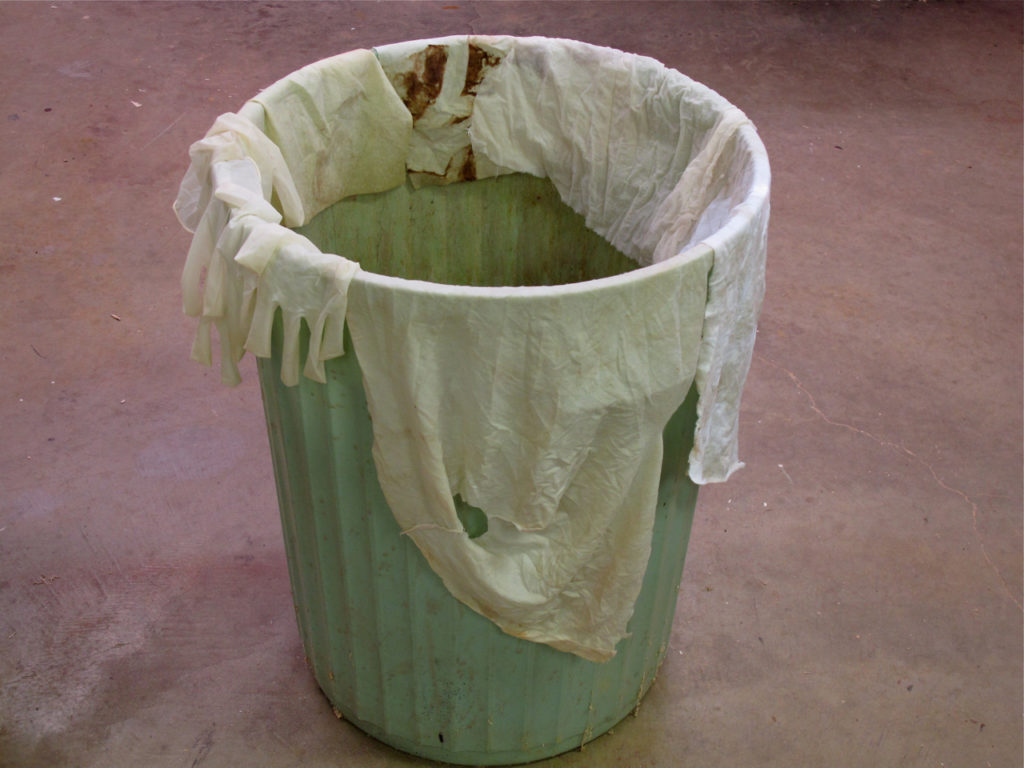We may receive a commission when you use our affiliate links. However, this does not impact our recommendations.

The simple way to deal with oil finishes and oil-based stains that could spontaneously combust is to drape the rags over the edge of a trash can until the rags dry. Then throw them in the trash.
Drying oils, especially linseed oil (raw or boiled), are the only finishing materials that spontaneously combust. Solvents don’t spontaneously combust, paint strippers (including paint or finish residue) don’t spontaneously combust, and no type of varnish spontaneously combusts. It’s not totally clear whether 100% tung oil can spontaneously combust, so treat it like it does.
As linseed oil dries, it generates heat as a byproduct. If you wad up linseed-oil-soaked rags or pile them on top of each other, the heat generated in the middle can’t dissipate. It builds up until it reaches the flash point of the cloth and it bursts into flame.
The easy and sure way to protect yourself if you use any product that contains linseed oil, including Danish Oil and all oil-based stains and glazes, is to hang your rags over the edge of a trash can or similar object or spread the rags out on the floor until they dry. Don’t pile them up, as this is no different than a wadded-up rag. Once dry, you can safely throw the rags in the trash. Dried oil on rags is no different than a dried oil finish or stain on a piece of wood.
If you work in a shop with several or more people, it’s wise to establish a protocol where everyone puts their oil-soaked rags into water or an air-tight container to ensure that no one forgets to leave them open to the air. But if you work alone, this shouldn’t be necessary.
However, submerging oily rags in water or putting them in an air-tight container isn’t the last step. When you take them out, they can still spontaneously combust because the oil hasn’t dried. So spread them out as described.
– Bob Flexner
Here are some supplies and tools we find essential in our everyday work around the shop. We may receive a commission from sales referred by our links; however, we have carefully selected these products for their usefulness and quality.










Bob, thanks for the reminder. I was surprised to read that varnish is not considered a danger to spontaneously combust. I must have just assumed that and lumped it in with drying oils like boiled linseed oil.
A semi-related question is why does a boiled linseed oil and varnish blend continue to release a strong odor months after it was applied when it is enclosed like the inside of a lidded bowl? The lid has been off for months to allow a full cure but the odor builds up when the lid is on. Would varnish continue to release odors too? Thanks.
Good information!
One thing bothers me about this article – the photo illustration. That looks suspiciously like a plastic trash can. I would suggest that a metal trash can be used – no chance of it catching fire.
Yes, I know that the way illustrated should work well, but it shows a couple places where the rags are at least two layers thick, which SHOULD not be a problem, but wouldn’t it be best to err on the side of caution?
Certain solvents are photochemically reactive and can form dangerous ether peroxides when stored in partially open containers. Acetone is one such bad actor and so is MEK to a lesser degree. The ether peroxides can ignite or explode when the volatile acetone evaporates from your rag or paper towel. The classic case is that the acetone evaporates completely to dryness in the can over years and the peroxides explode when you attempt to unscrew the cap to recycle the metal can or refill it.
Metallic drying agents (Japan Drier is one such potent mix used for paints and varnish) are catalysts added to speed up the oxidation of drying oils and are used in many oil based products to accelerate the drying process. As such they can greatly contribute to autooxidation, resulting in enough heat to spontaneously ignite the cellulosics in rags and towels. Working in a chem lab, I have seen many fires caused by dried out catalyst powders carelessly dumped on paper towels in waste baskets. Sand is the best solution to these fires and so is the the regular use of a Justrite safety trash receptacle with a spring loaded closed lid. Without a steady supply of oxygen, the autooxidation process is suspended. Wet the rags down and tie them up in a plastic bag before disposal will mitigate the fire potential completely. The bag will keep the rags wet for months and the amount of oxygen that can diffuse through the plastic will allow the oxidation rate to be slow enough so that the oils react and turn to dry solids while avoiding heat buildup.
I caused a very slow long burn fire in a mix of redwood sawdust and dried oil based paint when sanding the surface of a deck using a belt sander and blue zirconia belts. The protruding deck screw heads were quickly shaved down along with the sticky coating and redwood. The resulting metal shards ignited the sawdust mixture which burned for days like a peat fire until I noticed the spreading grey ash on the sawdust surface around my deck. A garden hose took care of the problem before the deck ignited and the process had been ongoing for several days before I noticed the spread of the dark ash zone. No smoke or heat that I could detect with my hand but it sizzled when doused with water. The nickel and chromium content in stainless steels makes a great catalyst when turned to fine powder. Never use your house dust collection system or shop vac for metal shavings and turnings when mixed with sawdust or general wood waste. Keep them separate at all times as the mix can autoiginte spontaneously.
In case there are any doubters out there, I tested this years ago with linseed oil under safe, controlled conditions and started a small fire. This is no joke! I haven’t tested it with tung oil, but that sounds like a good idea and I have some old oil that I need to dispose of, so I’ll try it and report back
Wonderfully clear treatment of a sometimes worrisome issue. Got it.
Thanks, Bob.
Rob Porcaro
Good advice. I have been using this method to dry oily rags for years and have found it to be safe and effective — and it doesn’t leave slick oil spots on the concrete floor of my shop.
When the rags are dry, and also useless at that point, I place them in an plastic paint pail with water and seal the top. Zero problems.
One does well always to remember and preempt the danger mishandling oil-soaked rags.
Thanks.
Thank you, Bob. Although this advice has been out there for years, it’s an important lesson for those who are at the beginning of their woodworking learning curve (and a good reminder for old timers, too). Over the years, I suspect that you’ve prevented almost as many fires as Smokey the Bear. Keep it up!